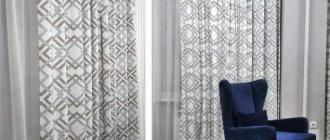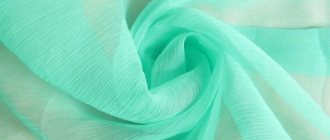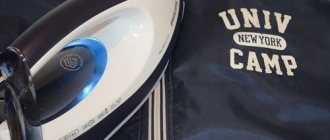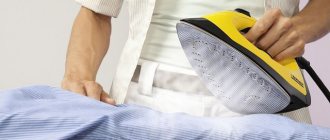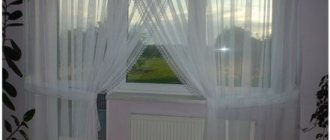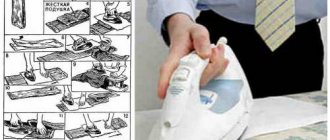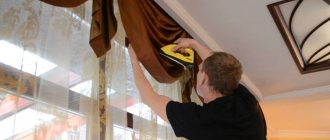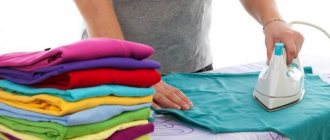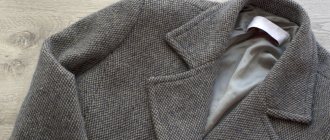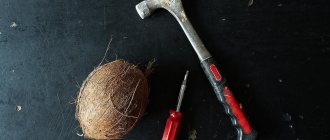Everyone knows how to iron curtains, but not everyone may know how to do it correctly with different fabrics. How to straighten curtains while hanging with a steamer or an iron? The correct, competent application of useful knowledge will help not to spoil the curtain with a burn from the iron, which is then very difficult to remove from the surface of any fabric.
Beautiful folds, smooth and even fabric delight the eye and lift your spirits
Hanging crumpled curtains is unthinkable - it’s like putting on an unironed dress
How to wash a bathtub curtain?
Place a curtain and several waffle towels in the drum of the machine (they will act as brushes). Instead of powder, add a glass of soda. After washing, to prevent the curtain from being wrinkled, hang it wet, lowering the edge into the bath
so that the water drains.
wring out the curtain
or iron it.
Interesting materials:
How to change your voice on VKontakte? How to change your voice during a call on Android? How to change your voice during a call on iPhone? How to change your voice during a phone call? How to change hotkeys in Skype? How to change hotkeys? How will the city change in VK? How to change the alarm volume on iPhone 11? How to change a group to a VK community? How to change a group in VK?
Is ironing necessary after washing?
The choice of ironing option depends on a number of circumstances:
- personal preferences;
- availability of special household appliances (steamer, iron);
- type of fabric;
- length and width of the canvas;
- the presence of decorative elements;
- features of the cut.
The determining factor is the composition of the fabric, which limits the heating temperature and the method of action when smoothing.
Procedure
Ironing on an ironing board is the standard approach to straightening fabric.
The difficulty of working with curtains concerns not only the need to iron most materials through additional fabric, but also the large size of the canvas.
Procedure:
- The ironing board is laid out directly under the window.
- Iron the top half of the fabric.
- Hang the curtain on the cornice.
- Iron the lower half of the canvas without removing it from the cornice.
The seams are ironed only from the inside out and through additional fabric.
How to iron a large curtain?
For large voluminous curtains, not even a standard ironing board can be used, but a larger flat surface, for example, a table. Or there is an option with a wide, long board covered (or sheathed) with thick fabric.
Ironing the curtain usually starts from the top edge . This raises a problem: how to prevent wrinkles in already ironed fabric? Freely descending matter can wrinkle even under its own weight.
To prevent this, it is recommended to use an additional device - a round smooth stick at least 1 or 1.5 meters long. Such a pole will help avoid creasing of already ironed curtains.
While pushing the ironed material from the board, it is loosely wound around a round stick . Once the entire length of the item has been ironed, it can be hung in place.
Steaming by weight without removing from the ledge
You can iron curtains hanging directly on the curtain rod as a preventive measure and for cleaning if steaming is used. This method is recommended for large voluminous curtains made of heavy material.
Using a steam generator or steamer gives very good results, but is not suitable for all types of curtains.
If there are no contraindications to the use of a steam generator or steamer, then set the minimum temperature and maintain the distance between the nozzle and the fabric. Processing is carried out systematically, by weight.
Steamers are:
- floor;
- manual.
| Steamer type | Characteristic |
| Manual | The manual version of the steamer is best suited for simple-to-cut curtain models. The disadvantage of the device is its low power and the need to use an extension cord. |
| Floor | Floor-standing models of steamers are suitable for complex draperies and a large number of folds. These are powerful devices that allow you to very quickly deal with folds in the material. |
Steaming can also be done using a regular iron , which has a vertical steam function.
In this case, the surface of the sole of the device should not touch the fabric. The impact will be performed from a distance, without direct contact with the sole of the iron. The use of hot steam is prohibited for thin and delicate fabrics.
Is it possible to do without an iron and steamer?
In the absence of special household appliances, homemade recipes will help eliminate crumpled areas on curtains.
If wrinkles are the result of improper drying and washing, then it is possible to correct the situation:
- repeated washing and proper drying;
- moistening the surface using a spray bottle with clean water;
- if the material allows, by spraying a special solution prepared from equal parts of vinegar, laundry conditioner and clean water.
General rules
Ironing after washing is a mandatory procedure for almost any curtains. There are some basic rules regarding the heat treatment of fabric products. For example, it is advisable to start working with an iron on damp curtains. This is especially true for dense fabric that does not smooth out well when dry.
The maximum ironing temperature is selected according to the type of fabric. It is important to understand that it should not reach its melting point. Typically, this information is indicated by the manufacturer on a label sewn on the reverse side. If there is no label, carefully run the slightly heated sole of the device over an inconspicuous area on the curtain. If the folds are smoothed out, feel free to continue the procedure.
Organza and delicate fabrics should only be ironed through a terry or cotton towel or cardboard. It is not recommended to use newspapers and colored materials, as there is a risk of staining and staining the curtains. Treat stitching areas and seams from the front side through a double layer of gauze. If possible, turn off the steam function. This will not harm curtains made of thick textiles, but thin curtains and tulle can go “in waves”.
When working with long items, start at the top of the curtain. This will make it possible to hang on the cornice the part of the product that has already been ironed. For convenience, you can use a round stick, a regular board or any other object at a height of 1-1.5 m. Walk along the lower section of the canvas and carefully wrap it around the stick. Next, begin ironing the rest of the surface, gradually winding up the fabric. At the end of the procedure, simply remove the pole from the skein and unwind the curtain.
How to wash curtains without ironing
To avoid the hassle of smoothing out curtain fabric after washing, follow these simple and effective tips:
- Wash on delicate cycle.
- Set the temperature to 30-40°C.
- Avoid spinning.
- Immediately after washing, hang the curtains on the curtain rod.
This method is suitable for curtains made from:
- flax;
- organza;
- headers;
- polyester;
- silks.
To properly wash thread curtains without having to iron them:
- Tie the product along the entire length with a cord.
- Place the curtains prepared for washing in a bag.
- You can set the medium spin program.
- The curtains should dry completely on the window, attached to the cornice.
It is prohibited to iron shower curtains. They are made from waterproof material. These products need to be washed, but there is no need to dry or wring them. To drain water from vinyl curtains, they are hung above the bathtub. You can straighten the folds on this product using a household hair dryer; direct a stream of hot air to the place that needs to be straightened.
The type of material dictates the rules
Each interior style dictates its own design rules. A large number of materials and design solutions allows you to choose the optimal curtain model for each room:
| Type of material | Ironing Features |
| Viscose or polyester | Curtains made of polyester and viscose do not attract dust and do not stretch during use. They can be ironed at low temperatures - no more than 150ºС. The steam function should not be used in this case. The iron is moved carefully, without stopping in one place. |
| Cotton or linen | Natural linen and cotton products allow the use of high iron heating temperatures. In order for the material to be smoothed, it must be slightly damp. If the curtain is already completely dry after washing, it must be moistened and ironed using steam. You can also iron with an additional damp cloth. |
| Organza or chiffon | After washing, such curtains can be immediately hung on the curtain rod when wet. But if the fabric is very wrinkled, then it can be smoothed through tissue paper at a minimum temperature. The use of the steaming function, as well as high temperatures, is prohibited - the material may become deformed and develop unsightly waves. |
| Taffeta or silk | Ironing should be done from the inside out at a low temperature - up to 110ºС. You cannot use steam or moisten the material, as this can lead to the formation of stains and streaks. |
| Capron | The easy-to-care material allows you to do without ironing at all. If you hang a freshly washed curtain evenly, you can do without ironing. Temperature range – up to 110-150ºС. |
| Veil | Iron delicate fabrics only through additional fabric. The steam function is turned off. No force is applied during the ironing process. |
| Blackout | Thick, light-proof fabric does not require ironing after washing. If jammed areas appear, they can be removed with a low-heat iron. |
| Velvet or velor | Fabrics with a small short pile cannot be ironed in the usual way. After washing, the curtain is wrung out through a terry towel and dried. Velvet and velor should be ironed extremely carefully, turning the front side onto a spread terry towel. |
In addition to curtains made from one type of fabric, there are models made from a combination of materials, as well as double-sided ones .
Combined curtain models are smoothed taking into account each type of fabric.
For lined curtains, straightening must be done for both the inside and outside, changing the heating modes of the iron and selecting suitable processing conditions.
Folk method
Alas, not everyone has steamers and modern irons. Nevertheless, it is possible to iron a product made of synthetic fabric well even with a minimum of possibilities.
How to iron polyester using traditional methods? To do this, the product must be placed suspended above a container of very hot water. This can be either a standard bathtub in an apartment or any tank. But the procedure must be carried out in a small room, so that steam fills the room and gradually smoothes out the wrinkles. Then the product is thoroughly dried. In essence, this is steaming, only more troublesome and time-consuming.
Tips and prohibitions
Some useful tips:
- When purchasing curtains, you should check for a label with information about proper care. If it is not available, it is better to consult with the seller what fabric they are made of and whether the product can be washed and ironed, and at what temperatures.
- If you have doubts about the name and properties of the fabric, it is recommended to contact a dry cleaner for the first wash.
Specialists will perform high-quality cleaning of curtains and give recommendations for further independent care.
- Only freshly washed curtains need to be ironed. Otherwise, stains and streaks may appear on the fabric, especially when treated with steam.
Before ironing, you must clean the soleplate of the iron (using a special pencil or spray).
Even a small lint, invisible to the eye, can melt and stick to the fabric when heated.- Curtains made of silk, nylon, polyester, organza and chiffon are ironed without steam, so as not to cause deformation of the fabrics.
- Products with embroidery, beads or rhinestones are ironed from the reverse side. When in contact with a hot surface, decorative elements may melt and stick to the soleplate, damaging both the iron and the curtain.
- For the front side of the canvases, gauze or fabric linings are used.
Steaming
Steaming is the second most popular method of ironing polyester fabrics. This is done using a steamer or an iron with a vertical steam function. The procedure is carried out as follows: the suspended product is treated with steam at a distance of several centimeters from the surface of the material. The device mode is “for delicate fabrics”.
The steaming process not only helps remove wrinkles from polyester, but also refreshes the item, rids it of surface dirt and unpleasant odors.
Drying
If you dry polyester items properly, you may not need to iron them. After spinning, the products are shaken and hung on the dryer, carefully smoothing out all wrinkles. The jacket and windbreaker should be hung directly on hangers, so the items will be leveled under their own weight.
Synthetic fabrics respond very well to forced drying if the air is not too hot. However, you need to be careful here, since many products are sewn from several types of fabrics at once, and not all of them will withstand such a procedure. For example, items with leather inserts should only be dried naturally.
Fabrics that won't iron
Some fabrics can do without any special actions aimed at smoothing. At the same time, curtains made from such materials look neat. These include:
- organza;
- chiffon;
- blackout.
To avoid having to iron the curtains, it is better to wash them by hand.
Proper hand washing requires compliance with the following steps:
- Remove the curtains from the windows. Fill the bathroom with warm water.
- Add laundry detergent. Gently lower the fabric into the water.
- If the product is made of organza, chiffon, silk, then it must be washed without soaking. Other materials can be left in water for 20 minutes.
- Wash delicate fabrics with stroking movements, without strong friction or wrinkling. Rinse the product in clean, cool water several times. Remove the curtains from the water without squeezing them.
- Hang the curtain and place a container to drain the water. Straighten the fabric with your hands.
- Hang the damp but not wet curtain in its place.
Errors
If you lack experience in ironing large items such as curtains, mistakes can be made. The most common ones include the following:
| Error | What can it lead to? | How to avoid? |
| Incorrect temperature setting on the iron. Steaming fabrics for which this method of straightening is prohibited. | If the temperature is insufficient, the curtain fabric will not straighten out, but will remain wrinkled. If the temperature is set higher than recommended, the material may deform, lose its shape, etc. | The product label contains all the necessary information. It is necessary to study it before you start ironing. |
| Iron directly on the front side of the curtain. | Unsightly prints and stains may appear on the front side. | It is advisable to iron through additional fabric or from the inside out. |
| Using colored fabric as an auxiliary additional fabric. | The fabric may fade, ruining the curtains. | As an additional fabric through which ironing is carried out, it is necessary to use a non-fading material, preferably cotton. |
| When ironing, the presence of decorative elements on the curtain is not taken into account. | Decorative elements may become deformed and damage the fabric of the curtains and the soleplate of the iron. | Decor on curtains cannot be ironed from the front side without auxiliary fabric. |

